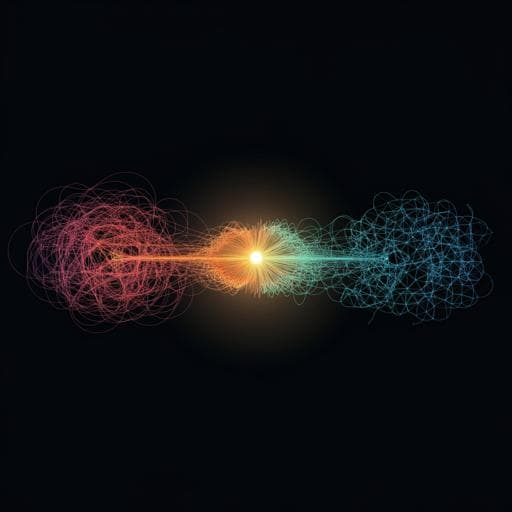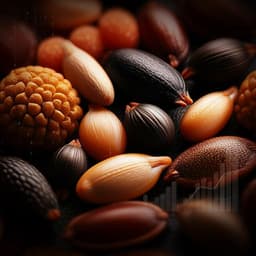
Physics
Neural-network decoders for measurement induced phase transitions
H. Dehghani, A. Lavasani, et al.
Discover the innovative research by Hossein Dehghani, Ali Lavasani, Mohammad Hafezi, and Michael J. Gullans on measurement-induced entanglement phase transitions. This study unveils a neural network decoder that revolutionizes the probing of complex quantum systems, making significant strides in understanding exotic dynamical phases. Engage with findings that promise to reshape experimental approaches in quantum science.
~3 min • Beginner • English
Introduction
Entanglement in isolated, thermalizing quantum systems typically grows to a volume-law, whereas coupling to an environment or measurement processes can suppress entanglement to an area-law. Hybrid random circuits with interspersed measurements exhibit a measurement-induced phase transition (MIPT) between volume-law (low measurement rate) and area-law (high measurement rate) entanglement. Probing this transition experimentally is challenging because entanglement-related observables depend nonlinearly on the density matrix and naive approaches require exponentially many repetitions due to randomness in measurement outcomes. A proposed workaround uses local probes: initially entangling a reference (ancilla) qubit to a local system qubit and tracking the ancilla’s purification dynamics, which reflects the phase (area- vs volume-law). The key task then is to construct a decoder that maps mid-circuit measurement outcomes to the reference qubit’s final state. While analytic decoders exist for special cases (e.g., stabilizer circuits), generic circuits (e.g., Haar random) lack tractable solutions. This work proposes and demonstrates a neural-network-based decoder that learns this mapping from trajectories, revealing the MIPT through a sharp change in learnability and enabling scalable detection of the transition.
Literature Review
Prior work established MIPTs in monitored many-body dynamics and hybrid circuits, including random unitary circuits with projective measurements, and linked these transitions to quantum error correction and purification transitions. The exponential sampling bottleneck for nonlinear observables was identified, and a scalable probe via local ancilla purification was proposed (Gullans & Huse). Connections to error-correcting code formation and statistical mechanics mappings have been explored. Machine learning methods, especially neural network decoders, have been successfully applied to quantum error correction and decoding problems, motivating their use here to learn trajectory-conditioned decoders for MIPTs. The present study builds on these threads: local purification probes of MIPTs and ML-based decoding, extending them to quantify learnability, complexity, and scalability, and to generalize beyond Clifford to Haar-random circuits.
Methodology
- Model and probe: Consider a brickwork hybrid circuit of L qubits and depth T with layers of random two-qubit gates followed by single-qubit Z measurements with probability p per site per layer (periodic boundary conditions). A reference qubit is initially Bell-paired with the central system qubit. The reference qubit’s final single-qubit density matrix is characterized by its Bloch components ⟨σx⟩, ⟨σy⟩, ⟨σz⟩; its entropy SQ(t) encodes coherent quantum information and exhibits distinct behavior across the MIPT.
- Decoding task: For a fixed circuit C, define a decoder Fc mapping the trajectory measurement record M (binary/ternary matrix indicating whether a qubit was unmeasured or measured with outcome ±1 at each spacetime point) to the reference qubit observables. Equivalently, for each Pauli P ∈ {X,Y,Z}, learn conditional distributions pP(m|M) for m=±1 so that ⟨σP⟩ = Σm m pP(m|M). In stabilizer (Clifford) circuits, the reference qubit is either fully mixed or fully purified along a fixed Pauli axis, reducing to hard classification of the final measurement outcome along that axis.
- Data generation: Use classically simulable random Clifford circuits (Gottesman–Knill) to generate trajectories: sample two-qubit Clifford gates, perform projective Z measurements stochastically with rate p, and record outcomes. For Haar-random circuits, sample two-qubit unitaries from the Haar measure. For each circuit and measurement basis P, collect N labeled samples (M, mP) by running the circuit multiple times.
- Statistical light-cone masking: Motivated by locality of information propagation and finite correlation time away from criticality, restrict inputs to a rectangular spacetime window centered on the initially entangled site that encloses the statistical light cone up to a cutoff depth (e.g., set by purification time tp). Compare training using only light-cone data versus full-circuit measurements.
- Learning schemes: (1) Conditional scheme: group circuits by their purification time tp (first time after which the reference qubit’s state no longer changes) and train/test within each tp to study sample complexity versus tp and L. Discard measurements after tp. (2) Unconditional scheme: train/test over randomly generated circuits without conditioning, to probe overall learnability and estimate coherent information dynamics from the fraction of learnable circuits.
- Neural network architecture and training: Use a convolutional neural network (CNN) suited for local feature extraction from the spacetime measurement snapshot. Architecture: two convolutional layers (kernels 4×4 and 3×3, stride 1×1, ReLU), max-pooling (2×2), dropout (rate 0.2), flatten, dense ReLU layer with size Nout=512·(1+2⌊N/2000⌋), dropout (0.2), final sigmoid output for binary classification of mP. Loss: binary cross-entropy; optimizer: Adam with learning rate 0.001. Hyperparameters chosen via empirical search for N ≤ 5×10^4 samples. For Haar circuits, train three independent networks (one per P ∈ {X,Y,Z}) to obtain ⟨σP⟩ estimates, then reconstruct a physical single-qubit density matrix via standard maximum-likelihood tomography.
- Complexity metrics: Define learning accuracy 1−ε on held-out data; M(ε) is the minimum number of training samples needed to achieve ε (fixed at ε=0.02). For conditional analysis, average M over Nc circuits with the same tp, targeting average inaccuracy δ=20%. For unconditional analysis, define Rp(N) as the fraction of circuits learned as a function of sample size N, which is bounded by the fraction purified by time T, Rp(T)=∫0^T rp dt, where rp is the purification rate.
- Critical scaling analysis: Estimate the decay rate of the coherent information S0(t) across sizes L and measurement rates p. In stabilizer circuits, S0(t)=1−Rp(t). Use the learned fraction of purified circuits to estimate S0^l(t), then analyze the early-time exponential decay with rate A=L^−z f((p−pc)L^ν). With z fixed near 1 (CFT expectation), analyze crossings and perform data collapse to estimate pc and ν; also scan z to test consistency with conformal scaling.
- Scalability tests: Train CNN decoders on smaller-width subcircuits (LB) that share the same gates within a narrow strip around the initially entangled site, then test on full-width circuits to assess transferability consistent with a light-cone picture.
- Additional setups: Also consider scrambled initial states obtained by first evolving a product state with random Clifford unitaries (no measurements) for T=L to produce a volume-law state, then entangling the reference qubit and running the hybrid circuit; repeat the complexity analyses.
Key Findings
- Learnability phase transition: In Clifford circuits, the purification (area-law) vs mixed (volume-law) transition manifests as a sharp change in learnability of the decoder. When the reference qubit is purified, the decoder can learn a deterministic mapping; when mixed, outcomes are random and hard classification necessarily fails. This operationally detects the MIPT.
- Sample complexity vs purification time: The minimum number of training samples M needed to achieve target error grows approximately exponentially with the purification time tp. This holds in both mixed (e.g., p=0.1) and pure (e.g., p=0.3) phases. Learning with light-cone-restricted inputs requires fewer samples than using all measurements, consistent with locality.
- System-size dependence: Using light-cone inputs, the asymptotic sample complexity shows weak dependence on system size L (tested for L∈{64,128} and extended up to L=128 in Methods), aligning with the expectation that the relevant input dimension is set by the light-cone window rather than total L.
- Unconditional learnability: The fraction of learned circuits Rp(N) rises quickly with N and then slows, reflecting exponentially rarer long-tp circuits needing exponentially more samples. Saturation is limited by the fraction purified by depth T. Results shown for T≈10 and L up to 64.
- Coherent information dynamics and critical scaling: Using the learned fraction of purified circuits to estimate S0^l(t), the temporal decay in the mixed phase matches exact simulation closely; in the pure phase, deviations emerge after a few time steps due to harder learning. Finite-size scaling of the learned decay rate shows crossings consistent with a transition near p≈0.13–0.15. Data collapse yields critical parameters pc≈0.14±0.03, z≈0.9±0.15, and ν≈1.5±0.3, consistent within uncertainties with known results from half-chain entanglement (z≈1, pc≈0.16, ν≈1.3).
- Scalability: Training on smaller-width subcircuits transfers effectively to larger circuits. The required training width LB to reach near-unity efficiency is set by the effective light-cone; for L∈{32,64} and T=10, LB≈20 sufficed.
- Generalization to Haar circuits: For L=8 Haar-random circuits (100 realizations, 5000 trajectories per circuit), training three Pauli-basis decoders and reconstructing the density matrix reproduces the distinct temporal behaviors of S0(t) in area-law and volume-law phases (pc≈0.17 for this model), demonstrating applicability beyond Clifford circuits.
- Scrambled initial states: With initially volume-law states, the conditional learning task is harder (higher sample complexity) than for product-state initial conditions, but retains the exponential dependence on tp and benefits from light-cone inputs.
Discussion
The study addresses how to probe measurement-induced entanglement phase transitions using experimentally feasible, local data. By framing the trajectory-conditioned reference-qubit decoding as a learnability problem, the MIPT becomes observable through a transition in the ability of a neural network to learn the decoder. Leveraging the statistical light-cone reduces input dimensionality and sample complexity, enabling scalability across system sizes and circuit widths. The learned coherent information dynamics yield critical behavior consistent with theoretically expected scaling (z≈1) and known estimates of pc and ν. The approach works in stabilizer circuits with rigorous benchmarks and extends to generic Haar random circuits via three-basis decoding and single-qubit tomography. These results indicate that neural decoders can serve as practical tools to detect and characterize MIPTs from local measurement records, with potential application in experiments and connections to dynamically generated quantum error-correcting codes.
Conclusion
This work introduces a neural-network decoder that maps mid-circuit measurement records to the state of a locally entangled reference qubit, providing a scalable probe of measurement-induced entanglement phase transitions. Key contributions include: (i) demonstrating a learnability transition aligned with the purification/entanglement transition; (ii) quantifying sample complexity, showing exponential growth with purification time and strong benefits from light-cone-restricted inputs; (iii) extracting critical parameters (pc≈0.14±0.03, z≈0.9±0.15, ν≈1.5±0.3) consistent with prior studies; (iv) establishing scalability by training on smaller-width subcircuits; and (v) generalizing the method to Haar-random circuits via multi-basis decoding and tomography. Future work includes improving decoder architectures for deeper circuits, extending to long-range and symmetry-constrained MIPTs, incorporating realistic experimental noise and errors, exploring decoders for other dynamically generated logical qubits, investigating effective Hamiltonian learning for monitored dynamics, and evaluating unsupervised learning approaches.
Limitations
- Most quantitative results and scaling analyses are performed on Clifford circuits; extension to generic (Haar) circuits is demonstrated at small sizes (L=8) with limited ensembles, without full critical exponent extraction.
- Learning performance degrades for deep circuits and in the area-law (pure) phase at longer times, limiting accuracy of late-time coherent information estimates.
- The purification axis is unknown in generic circuits, requiring training three separate decoders and subsequent tomography, increasing data and computation costs.
- Estimated critical parameters have sizable uncertainties; more precise determination would require larger systems, deeper circuits, and larger datasets.
- The CNN decoder used may not be optimal; some residual system-size dependence in sample complexity is observed.
- Experimental noise and gate/measurement errors are not explicitly modeled; robustness to such imperfections remains to be fully characterized.
Related Publications
Explore these studies to deepen your understanding of the subject.







